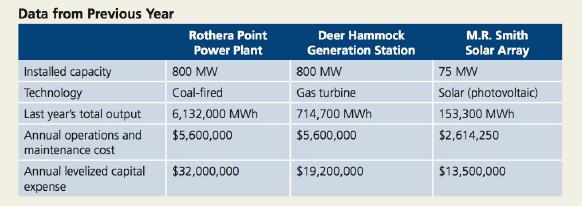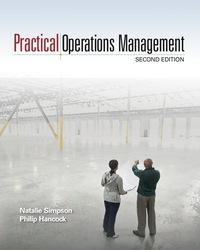Rothera Point Utilities (RPU) provides customers with 7 million megawatt-hours (MWh) of electricity each year. RPU operates
Question:
Rothera Point Utilities (RPU) provides customers with 7 million megawatt-hours (MWh) of electricity each year. RPU operates three different generation facilities to meet this demand: the Rothera Point Power Plant, the Deer Hammock Generation Station, and the newer M.R. Smith Solar Array. Both Rothera Point and Deer Hammock have capacities of 800 megawatts (MW) each, although their daily operation is much different. RPU's Rothera Point Power Plant is a conventional coal-burning power station that operates at a steady pace throughout the year. In contrast, Deer Hammock houses two combined-cycle gas turbine generators, which start up and shut down as customer demand for electricity rises and falls throughout the day. RPU's third facility, the M.R. Smith Solar Array, is a commerical photovoltaic solar farm, covering 50 acres with panels that combine for a peak output of 75 MW, given the sun is shining. These facts and the costs common across each of these facilities are summarized in the Data from Pre- vious Year table.

Annual operations and maintenance reported in the table are the direct costs of running the facility, not including fuel. Levelized capital expense reflects RPU's annual payment on the original investment required to construct the facility, prorated over its expected lifespan. What does not appear in the table is the issue of fuel for each facil- ity, because this issue differs among them. Rothera Point Power Plant burns half a ton of coal for every megawatt-hour it operates, meaning that it requires 350 tons of coal to run for 1 hour at its preferred operating level of 700 MW. Last year this coal cost RPU an average of \($190\) per ton, including delivery to the plant. Natural gas is sold by volume, not weight, and last year RPU purchased natural gas for Deer Hammock at an average rate of \($12\) per 1,000 cubic feet. When operating, Deer Hammock consumes 10,000 cubic feet of natural gas per megawatt-hour of electricity provided. In contrast, the M.R. Smith Solar Array has no fuel costs, only availability issues. The M.R. Smith installation does not include any system for storing electricity, and thus can only con- tribute to RPU's generation during daylight hours, contributing less when the weather is not favorable. Generally, only coal-burning Rothera Point operates overnight, because its preferred operating level matches this baseline demand nicely. RPU then adds full use of the solar farm's output as the sun rises and customer demand for electricity increases, firing up the gas turbines at Deer Hammock to fill in as demand spikes above the combined capabil- ity of the first two facilities. RPU is concerned by recent rumors that a tax may be placed on CO2 emissions from power plants, which has particular implications for RPU because of its heavy reliance on Rothera Point. Rothera Point's coal-burning generators release 2,000 pounds of CO2 for every megawatt-hour of electricity generated compared to only 1,100 pounds of CO2 per megawatt-hour from Deer Hammock and no emissions from M.R. Smith.
Questions
1. Calculate the multifactory productivity of each RPU generation facility, based on last year's data. Are your findings consistent with RPU's current use of these facilities?
2. Suppose that a tax is imposed on CO emissions at a rate of \($0.10\) per pound of CO2. What would be the total annual tax payable at Rothera Point and Deer Ham- mock, assuming last year's operating levels? What are their updated productivity measures?
3. If a tax rate of \($0.10\) per pound of CO2 emission were imposed next year, would you advise RPU to change its operating strategy for its current three plant system? Explain your reasoning.
4. Given the rumors of a tax on CO and potential changes to fuel prices in the future, should RPU change its installed technology mix in the long run? Within these tech- nologies, how would you recommend RPU distribute the 7 million MWh of electri- cal output among the three generation processes in the future system, given it can invest further in any of them?
Step by Step Answer:






